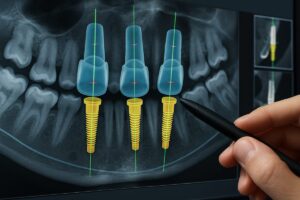How Bone Grafting Can Support Your Dental Implants
Dental implants have revolutionized dentistry, providing a durable and natural-looking solution for missing teeth. However, for some individuals, insufficient bone volume can pose a challenge to successful implant placement. This is where bone grafting comes into play. It offers a crucial support system to ensure the stability and longevity of dental implants.
Understanding bone grafts
One of the prerequisites for a successful dental implant is an adequate amount of jawbone. Factors such as tooth loss, gum disease or trauma can lead to bone loss, making it necessary to augment the bone structure through grafting.
Bone grafting involves transplanting bone tissue to the deficient area. There are various types of bone grafts, including autografts (taken from the patient’s own body), allografts (from a donor) and synthetic grafts (laboratory-made materials). The choice depends on your individual needs and preferences.
The bone grafting process
Bone grafting begins with a thorough examination by Dr. Mike and your Cleveland Implant Institute care team. X-rays and imaging help us assess the current state of the jawbone and determine the optimal approach for bone grafting.
If you need bone grafts, that will happen before implants are placed. During the grafting procedure, the selected bone graft material is placed in the targeted area. The body gradually incorporates the graft into your jawbone, promoting the growth of new bone tissue.
The duration of the bone grafting process varies depending on factors such as the extent of bone loss, the type of graft used and individual healing responses. In some cases, the graft may take several months to integrate fully, so the implants can be placed. Dr. Mike and your care team will give you an estimate of how long your grafts will take to heal.
After the graft heals, the dental implant procedure follows. While requiring bone grafts adds time to the overall process, it significantly contributes to the long-term success of the implants. Ultimately, the result is a permanent and natural-looking solution to missing teeth and jawbone loss.
How bone grafts support implants
Bone grafting creates a strong foundation, ensuring there is sufficient support for the dental implant. This stability is crucial for the successful integration of the implant with the jawbone. Bone grafts also help recreate a natural-looking gum line and facial structure, enhancing both the aesthetic and functional aspects of the dental implant.
Not all dental implant patients will require bone grafts—but if you do, Dr. Mike and your care team will ensure that your jawbone can properly support your implants for a lifetime of great smiles.
In short, bone grafting helps overcome the challenges posed by insufficient bone volume, laying the groundwork for successful dental implants. While the process may extend the overall timeline, the benefits in terms of stability, aesthetics and functionality make it a valuable investment in your oral health. Consultation with Dr. Mike will help determine the most suitable approach for your specific needs, ensuring a strong foundation for your smile—call today to schedule an appointment.
Mentor Office
6303 Center St
Mentor, OH 44060-2467
Concord Office
8245 Auburn Road
Concord, OH 44077






